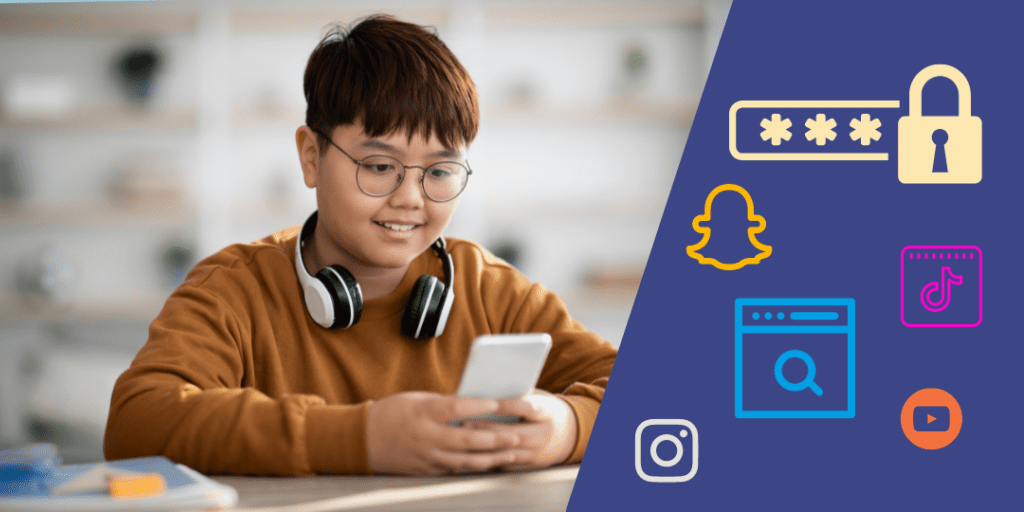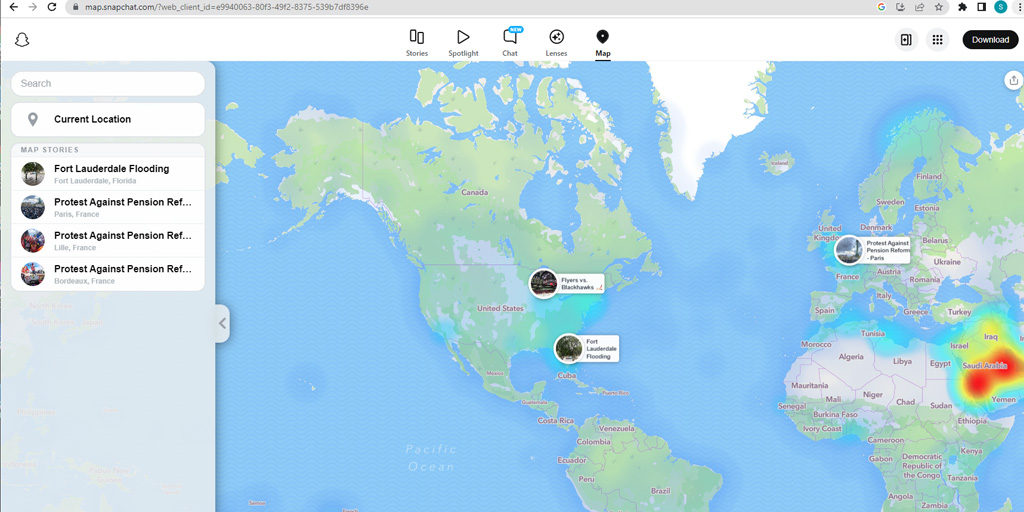
As a parent, it’s important to stay in tune with your child’s online world. Having access to their passwords allows you to monitor who they’re communicating with and what content they’re accessing on the internet. Knowing your kids’ passwords also protects them from inappropriate content. Here are some of the benefits of having your kids’ online passwords.
If you have your kids’ logins for social platforms and other online services, you can help them choose stronger passwords that are more likely to stay secure from hacking attempts since weak passwords are more prone to breaches.
You'll also be able to make sure their online accounts have two-factor authentication (2FA) enabled as an additional layer of security, further reducing the risk of theft or hacking attempts by people who might want access to those accounts without permission.
Having your kids’ passwords allows you to monitor your child’s online activity and messages, either by accessing their devices directly or by using monitoring apps.
Why monitor your kids’ online activity? There’s a lot of content out there that’s inappropriate for certain age groups, and it’s easy for kids to access questionable content — both accidentally and on purpose. If you’re monitoring your kids’ activity, you can help guide them when they run into a situation they weren’t ready for.
Bullying is an issue across age groups, so if you’re keeping an eye on your kids’ online interactions, you can help your children through potential bullying situations as they arise, before they escalate.
We recommend using an app so that you can keep a discreet eye and ear on what your kids are doing online, without asking them to hand over their phone or tablet. BrightCanary is a monitoring app that you open on your own phone to see what potentially concerning content your kids have viewed, or show you everything they’ve viewed — your choice.
If you know what your kids are up to online, you can have better conversations about internet safety and digital citizenship. An open dialogue helps kids understand why we need rules, why some content is okay but not other content, and what information we share and keep private.
Having your kids’ passwords can save you from going through lengthy password recovery processes. Video game platforms are especially clunky when it comes to password recovery — the steps and checks can seem endless.
It’s good that platforms have security measures in place, but it’s super inconvenient when you lock yourself out of your own account. If you have your kids’ passwords, you’re ready.
💡 Download your free Password Keeper and have all of your logins conveniently in one place.
If you have access to your kids’ passwords, you can enable parental controls — either through the devices themselves, or on an app’s built-in parental control settings.
Sometimes kids get upset when you put restrictions on their devices, but they get used to it. Let them know that you will revisit their settings often and adjust them as they get older and develop their tech smarts.
If your child's password is ever compromised, you will be able to quickly respond and change it before someone has a chance to do harm with it.
In cases when devices or accounts are connected to a parent account, you will sometimes get alerts to your parent account when there’s unusual activity on your child’s device. It all depends on what behaviors trigger an alert, and what device and app settings are activated.
Having your children’s passwords can provide you with an extra layer of security while they are exploring the digital world. Remember, as a parent, it is your responsibility to make sure that your kids are not exposed to any dangerous or inappropriate content online. Keeping their passwords secure will also help protect them from identity theft, phishing scams and other online fraud. This way you can ensure that your kids have safe and enjoyable digital experiences.

A lot of children watch YouTube on their parent’s account or when not logged in at all. Sure, it’s easier to avoid the hassle of creating a child YouTube account, but there are reasons why your child should have their own YouTube Account that's separate from yours.
Read on to learn about the benefits of creating a YouTube account for your child and whether or not you should allow them to post videos on the app.
YouTube suggests videos based on what you search and watch. When you finish watching one video, it will suggest what to watch next. If you take no action, YouTube will choose for you and start playing the next video automatically.
If your child doesn’t log in to a YouTube account, they start fresh every time — which means they could be served content that’s not of interest to them or possibly inappropriate for their age.
What happens when you share an account with your child? You might have to skip through a few CoComelon nursery rhymes while you’re trying to catch up on highlights from last night’s game. Or, your child might be happily watching one Peppa Pig episode after another when she ends up on a “how to fix a dripping faucet” tutorial because you were watching a plumbing video earlier.
Things get dicey when you, as an adult, are consuming content that’s appropriate for you, but not necessarily appropriate for kids. If you watched the Dahmer documentary trailer last night, YouTube might later serve your child true crime videos that are too disturbing for them. Remember, YouTube thinks that everyone watching under one account is the same person.
Separate accounts can help ensure that you see what works for you, and your kid sees content that’s appropriate for their age.
If your child has their own YouTube account, you can link a parent monitoring tool to their account and stay on top of what types of content your child is consuming.
If you share an account, the app doesn’t know when you’re watching versus when your child is watching.
A harmful content alert from your child’s watch history might get buried among alerts from your watch history, and you might miss out on an important conversation with your child. Separate accounts ensure that you know when your child is viewing inappropriate content.
Monitor your child’s YouTube account free for 7 days with BrightCanary.
YouTube has a minimum age requirement of 13 to create an account. If your child is younger than 13, you can create a YouTube Kids account for them under your account. YouTube Kids filters content and shows videos that are appropriate for younger viewers. You can also control the settings and restrict mature content or search results.
YouTube Kids also has parental controls that allow parents to block content, share specific content with your child, turn search on or off, review your child’s watch history, and more.
It's not a perfect solution—inappropriate content sometimes gets through. But it's far better than letting them roam the internet without any filters at all. A good monitoring tool can help bridge the gap — unlike other apps, BrightCanary can also monitor YouTube Kids.
Creating content for YouTube comes with an entirely different set of concerns than consuming content, including:
As a parent, only you can decide what your child is ready for and what kind of risk you’re willing to take on. If they’re insistent, you can consider letting them post unlisted videos, which aren’t available through search. Only people you share them with can view them.
Ultimately, the decision of whether or not to set up a separate child YouTube account is up to you. If you do decide to set them up with their own account, be sure to monitor their activity and check in regularly with them about the content they’re consuming. With some precautions in place, a YouTube account can be a great way for your child to learn and explore their interests.

If you’re the parent of a teen or tween, you’ve probably heard of TikTok. The video-sharing app has skyrocketed in popularity in recent years, with more than one billion monthly users worldwide.
According to a 2022 survey from the Pew Research Center, TikTok is now the most popular social media platform after YouTube among teenagers aged 13 to 17.
But there are ongoing concerns that the app’s algorithm for pushing video content and encouraging endless scrolling endangers the mental health of teenagers and young children. Several U.S. states have launched investigations into TikTok’s potentially harmful effects on young users.
As a parent, there are steps you can take to protect your child from harmful online content. TikTok’s Family Pairing feature allows you to link your account with your child's so that you can monitor their usage and control what they watch.
With Family Pairing, you can:
Read on to learn how to pair your child’s TikTok account with yours.
Before getting started, you’ll first need to create your own TikTok account. Once you’ve done that, you’ll need your phone with the app installed, as well as your child’s phone to set up Family Pairing.
From your child’s device:
That’s it! You’re connected.
While you have your child’s phone and TikTok account open, it’s a good idea to set a password. There’s a good chance your child didn’t set one when they created their TikTok account.
From here, you have options.
The Daily Screen Time feature allows you to control how much time your child spends on TikTok each day. You can choose 40 minutes, 60 minutes, 90 minutes, or 120 minutes. The feature generates a code so you can allow your child more time if you choose.
If you activate Daily Screen Time, your child won’t be able to log out and switch to another account to bypass any time limits.

Restricted Mode filters out inappropriate content — to a point. It’s not perfect, and the app invites parents to report any harmful content that gets through.
As with Daily Screen Time, if you have Restricted Mode activated, your child will not be able to log out and switch to another account.

Here, you can turn the search feature on or off. If it’s off, your child’s feed will be limited to what the app shows. Your child will not be able to look for specific types of content.

Under the Family Link Privacy and Safety section, you have a few settings to choose from:
Even with Family Pairing in place, parental controls can only go so far. It’s important to keep a close eye on what your child consumes with a monitoring app like BrightCanary to keep them as safe as possible.
TikTok Family Pairing takes only a few minutes to set up and allows you to regulate your child's screen time, filter inappropriate content, turn their search function on or off, and set up privacy settings to limit who can contact them or add them as a friend. Still, the best line of protection is to keep an open line of communication between you and your child. Ask them what kinds of things they see on TikTok, what their favorite types of videos are, who their favorite creators are, and ease into safety topics. With regular check-ins, they'll get used to keeping it all out in the open.

When it comes to kids, electronic devices get a bad rap. But let’s face it — these days, iPads and smartphones can be a classroom tool, a way to stay connected to friends and family, and a source of entertainment. Still, too much screen time may lead to negative effects. That’s why, as a parent, it’s important to help your child develop healthy habits and set guidelines around screens. How much screen time is too much? How do you draw the line in a hyper-connected world?
Here are some tips for setting up successful screen-time boundaries.
Screen time is the amount of time spent using electronic devices such as smartphones, tablets, and computers. It can also include watching TV and playing video games.
A growing body of evidence suggests that excessive screen time has negative physiological and psychological effects. For example, one study found that toddlers who interacted with screens more at ages 24 and 36 months performed more poorly on a screening measure assessing development milestones at 36 and 60 months. A meta-analysis looking at children through age 18 found that screen time was associated with negative psychological outcomes, while “green time,” or contact with nature, was associated with positive psychological outcomes. Another study found that excessive screen time exacerbated suicidal behavior in tweens.
According to the National Library of Medicine, excessive screen time for kids could lead to:
Common Sense Media reports that tweens are using devices for 4 hours and 44 minutes per day, and teens are using screens for 7 hours and 22 minutes per day.
There is no one-size-fits-all answer to this question. Every family and child is different, so it’s important to consider your individual needs when deciding how much screen time is appropriate.
The American Academy of Pediatrics (AAP) has clear guidelines limiting screen time for children under two years old:
| Under 18 months | Screen time is discouraged, except for video chatting |
| 18 to 24 months | High-quality programming or apps, used together with caregivers. Children in this age range should not use media by themselves. |
| Over 2 years | Screen use should not exceed 1 hour per day of high-quality programming. View or play on devices with your children, and to engage in plenty of screen-free activities with your children as well. |
For kids aged 5 and older, the AAP previously advised they should have less than two hours of screen time per day. They've since changed their approach because most kids use screens for more than two hours daily, and not all screen time is the same. Now, they recommend that families create a plan that works best for them, considering their children's screen usage and their family's unique needs. They also urge parents to help their children develop healthy media habits in their early years.
Additionally, you may want to create rules that limit screen time during certain times of the day or week, such as mealtime and bedtime.
The AAP also encourages parents to ensure that their children get sufficient sleep, physical activity, and plenty of media-free activity. Additionally, the AAP suggests that bedrooms should be a screen-free zone.
The American Academy of Child and Adolescent Psychiatry (AACAP) has produced similar guidelines, and also recommend that parents turn off all screens during family meals, educate themselves on parental controls, and avoid using screens to babysit children or to quiet a child who is upset.
To encourage quality sleep, the AACAP suggests that screens should be removed from bedrooms 30-60 minutes before bed.
While recommendations start with the baby years, there’s no need to feel guilty if you’re still in the process of learning about the guidelines or if your child is used to more screen time than the guidelines recommend. It’s never too late to start healthy screen time habits.
Screen time isn’t inherently bad – in fact, it can be an educational tool if used the right way. But there are plenty of other activities that can keep your child entertained and engaged. Here are some screen-free activities to consider:
To check screen time on your child’s iPhone, go to Settings, then click Screen Time. From there, you can monitor and manage your child’s device usage.
To check your child’s screen time from your device, Family Sharing must be active for your children. Go to Settings, Screen Time, then choose the child whose screen time you’d like to view. In addition to viewing their total time online, you can set a number of controls, such as down times, content restrictions, and you can block specific apps from being used.
To check screen time on your Android, open the Settings app and scroll down to "Digital Wellbeing & Parental Controls." This will give you access to various tools that allow you to monitor and manage your child’s device usage as well as control content restrictions. You can also set limits for individual apps or overall total daily screen time.
It’s never too early or too late to put healthy device boundaries in place. Here’s how to go about it.
These are meant to get you started. You don’t have to use all of these, and you don’t have to implement them all at once. Pick a few at first, and see how they work for your family. It can be overwhelming to make several changes in one swoop, so start slow and add guide rails incrementally.
Creating healthy screen time habits for your family can help keep everyone safe, connected and engaged in activities other than screens. It’s important to set limits on the amount of screen time your child is allowed each day. When deciding what works for your household, consider how much time you as a parent want to allow, be mindful of your child’s current habits, and then set limits depending on your child’s age and development stage. Start with small increments and work up from there as needed.
When it comes to setting limits on screen time for kids and teens, having clear guidelines in place will help them stay healthy and create balance in their lives. Make sure they are following AAP recommendations and that they are engaging in other activities such as outdoor play, reading and socializing with friends. Additionally, monitoring activity can be a great way to ensure your teen is staying within set guidelines.

Kids and teens are using Snapchat more and more as a primary way of communicating. With its lighthearted cartoon interface, it’s a fun way to keep connected with friends and family — that’s why they’ve racked up over 360 million daily users. However, like any other social media app, Snapchat can be used improperly.
This is why it's important to monitor your child's usage and set some basic rules. Here are some tips for setting up Snapchat privacy settings, so your child can use the app safely.
Snapchat is a free social media app available for Android and iOS devices that allows users — known as Snapchatters — to share messages, pictures (Snaps), and videos with their friends and family.
When a someone posts a Snap, it's sent out to all of their followers who can view it for a limited time before it disappears. Snapchatters can also send their Snaps to multiple recipients simultaneously, making it perfect for sending group multimedia files to a group of friends or classmates.
By default, a one-on-one message immediately deletes after a Snapchatter views it. If it remains unopened, the message will automatically delete after 31 days.
Users can choose to change this setting and set the messages to delete immediately after the recipient views them. This setting triggers all previously reviewed messages to disappear.
Group messages delete after 24 hours of all recipients viewing them or one week after they were sent, whichever comes first.
Keep in mind that messages may stay on Snapchat’s servers, even if they appear deleted to the user. So it may be possible to retrieve messages in certain situations.
Message viewers can always screenshot messages, or save messages in the app by pressing and holding. After saving a Snap, the Snap will appear in the chat as Chat Media.
Users can delete a Snap in the Chat window by pressing and holding it, then tapping “Delete.” Snapchat sets it to delete user-deleted messages from its servers, and as long as friends are using the most recent version of Snapchat, the app will delete the message from their devices as well.
Snapchat draws in tweens and teens by gamifying app use. Snapchat Streaks and Snap Scores encourage kids to repeat certain behaviors in the app and engage in friendly competition with each other.
A Snapchat streak is when you and another Snapchatter have been sharing snaps within 24 hours over three consecutive days. The more the Snapchatters exchange snaps, the stronger the streak gets.
You’ll know when you and a friend are on a Snapchat Streak because the fire emoji will appear. And you’ll know it’s about to expire because the hourglass emoji takes place of the fire emoji. The hourglass encourages users to keep the streak going before it disappears completely.
The number next to the fire emoji represents the number of days the Snapstreak has been going, so kids are encouraged to get that number as high as they can.
A Snapchat score or Snap score is a measure of how active a Snapchatter is on the app.
A high Snap score shows your child has been busy sharing content, snaps, watching videos, chatting, and interacting with other Snapchatters. While the Snap score doesn't give the Snapchatter any special perks, it's a great way to earn bragging rights. Kids compete with each other and show off their high scores.

Snap Map allows Snapchatters to share their physical location in real time. This feature displays where your child is throughout the day and updates in real time.
While it's a fun way to let your child's friends know what they are up to, there might be times when you don’t want people to know where your child is, and there may be people you want to exclude from knowing where your child is.
The feature can be helpful, because you as a parent can check in on where your child is. But, before you allow the Snap Map to display your child, consider who might also be keeping tabs.
The good news is, you can turn it off.
Fortunately, you can hide your child's location by entering Ghost Mode. In Ghost Mode, your child’s location is hidden.
Snapchat Stories lets a Snapchatter share something with all their followers at once. Your child creates a story through a collection of memories, such as Snaps and videos.
Once a Snapchatter taps on the circle, it auto-plays through the content they’ve selected.
Stories are set to delete after 24 hours. However, if they are a Snapchat+ subscriber, they can customize the stories' timer to change when the stories delete.
It's crucial to know that Stories are public, all the more reason to learn how to activate Snapchat privacy controls.
To restrict those who can watch your child's stories:
There aren't any built-in Snapchat parental controls, but you can leverage the app’s privacy settings to ensure a safer Snapchat experience for your child:
To change who can contact you child:
The Quick Add feature suggests Snapchatters with similar interests to your child. If you want your child to interact with only people they know in real life, you won’t want them to appear in Quick Add suggested users. To uncheck it:
Once you are in the account:
Other privacy settings include:
Snapchat parental controls are part of keeping your child safe while using the app. The other part is talking and monitoring their usage.
Here are some talking points to get you started.
Every social media platform has its own set of safety issues. Fortunately, Snapchat privacy controls can add a protective layer between your child and the rest of the world. Monitoring your kids' online activities goes a long way to keep them safe, so keep tabs on your teen or tween’s social media activity. Most importantly, let them know that you’re in this together and they can always ask for help.